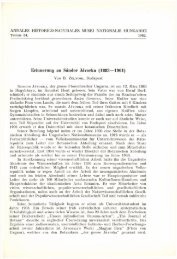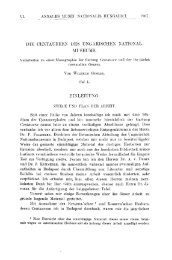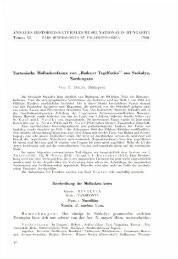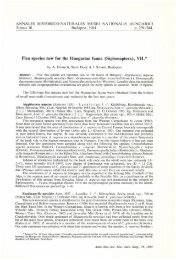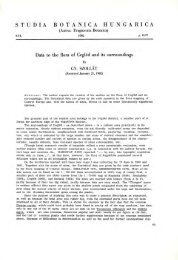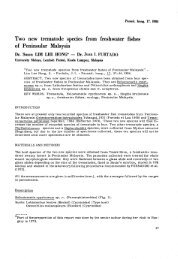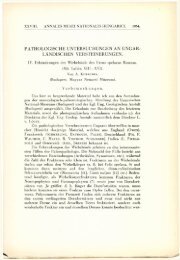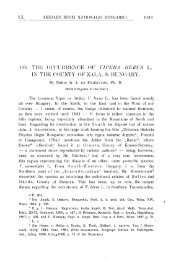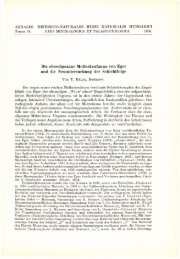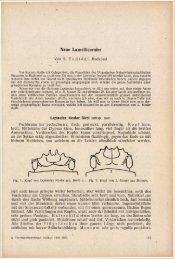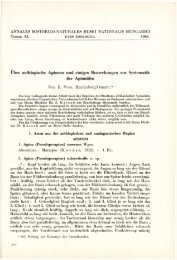New and little-known species of Carabidae from the Middle East and ...
New and little-known species of Carabidae from the Middle East and ...
New and little-known species of Carabidae from the Middle East and ...
Create successful ePaper yourself
Turn your PDF publications into a flip-book with our unique Google optimized e-Paper software.
48 E. Kirschenh<strong>of</strong>er<br />
List <strong>and</strong> distribution <strong>of</strong> <strong>the</strong> <strong>species</strong> <strong>of</strong> <strong>the</strong> genus Taridius<br />
Subgenus Taridius CHAUDOIR, 1875<br />
Taridius opaculus CHAUDOIR, 1875, type <strong>species</strong> – Nor<strong>the</strong>rn India (type locality), Myanmar,<br />
Nepal. <strong>New</strong> record for Nepal: “Nepal (Chitwan), Rampur, IAAS Camp, light<br />
trap, V.2005, D. Ahrens” (1 female, CDW). Note: holotype, female (Fig. 26), MHNP,<br />
examined.<br />
Subgenus Perseus KIRSCHENHOFER, 2003,<br />
Taridius <strong>and</strong>rewesi EMDEN, 1937 – Indonesia: Java<br />
Taridius birmanicus BATES, 1892 – Myanmar<br />
Taridius jendeki (Fig. 35) – India: Meghalaya<br />
Taridius niger ANDREWES, 1935 – India: Madras<br />
Taridius nilgiricus ANDREWES, 1935 (Fig. 31) – South India: Nilgiri Hills<br />
Taridius pahangensis (KIRSCHENHOFER, 2003) (Perseus), – Malaysia: Pahang:<br />
Cameron Highl<strong>and</strong>s<br />
Taridius stevensi ANDREWES, 1923 – India: Sikkim, “North India”<br />
Taridius vietnamensis (KIRSCHENHOFER, 1996) (Cymindis), (Fig. 38) – Vietnam<br />
Taridius wrasei (Fig. 37) – Malaysia: Sabah<br />
Taridius sabahensis (KIRSCHENHOFER, 2003) (Perseus), (Fig. 28) – Malaysia:<br />
Sabah<br />
(Fig. 35)<br />
sp. n.<br />
Type material – Holotype (female): “NE–India: Meghalaya, W Garo Hills, Nokrek<br />
NP, ca. 1100 m, 25°29.6”N, 90°19.5 “E, 9.–17.5.1996, leg. Jendek & Sausa” (NMW).<br />
Description – Habitus: Fig. 35. Length 7.8 mm, width 3.3 mm. Colour <strong>and</strong> lustre:<br />
head <strong>and</strong> pronotum black; pronotum with anterior margin, marginal groove <strong>and</strong> middle <strong>of</strong><br />
basal margin lighter brownish; elytra yellowish brown with black spots; first spot behind<br />
base, extending to intervals 1 to 4; second spot behind humerus, short <strong>and</strong> elongate, on interval<br />
8; a broader spot in about middle narrowing outwards <strong>and</strong> connecting with moderately<br />
wide spot on intervals 5 <strong>and</strong> 6, latter spot in middle <strong>of</strong> intervals 7 <strong>and</strong> 8; sutural<br />
interval also black; interval 9 <strong>and</strong> sides reddish yellow; m<strong>and</strong>ibles, palps, antennae <strong>and</strong> legs<br />
reddish yellow; ventral side blackish brown; pronotal <strong>and</strong> elytral epipleura yellowish<br />
brown; dorsum ra<strong>the</strong>r dull due to distinct microsculpture.<br />
Distribution – Nor<strong>the</strong>astern India: Meghalaya.<br />
Etymology – It is named after one <strong>of</strong> <strong>the</strong> collectors, EDUARD JENDEK.<br />
Annls hist.-nat. Mus. natn. hung. 102, 2010



